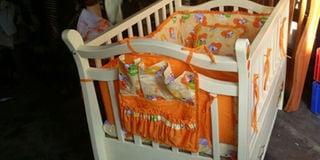Prime
A cot that suits your baby

Baby cots come in different types, sizes and materials. However, before buying one, you need to consider a number of things. Photos by Rachel Mabala
What you need to know:
The most impressive thing to a mother of a newborn is if the baby can sleep soundly throughout the night and part of the day. One of the ways of attaining this is by getting the right cot or crib as experts explain to Eseri Watsemwa.
By the time Priscilla Namasaba had her third child, she had learnt that sharing a bed with the baby was uncomfortable for her husband. So a few months to the delivery date, she bought a metallic baby crib that she used not only for that baby but also passed to her eldest grandson.
Just like Namasaba, a number of couples today shun the idea of sharing a bed with their babies.
They have, therefore, adopted the use of baby cots or cribs where their little bundles cuddle up to sleep.
However, for those who have either adopted or are planning to adopt this system, have you ever stopped to think about the cot your baby should sleep in and why?
The cot and why you need it
Gloria Kawuma, an interior designer, defines a baby cot as the “baby’s home”. She says, “That is where they spend most of their time. They only come out to go swimming (bathe), go to the hotel (mummy’s breasts) and go back home (crib). This is why parents should take time in choosing the best crib. Some of the things they need to consider when buying them is the colour, design and accessories.”
Kawuma, adds, “You can use the crib or cot from day one of your new born. For twins, it is recommended that they share a crib for the first four months.”
She explains that if you choose to sleep with your baby from the onset, it will be very hard to transfer them to a cot afterwards. Some people think they are being mean-but, it’s training.
She says, “As a parent, you need to rest to rejuvenate yourself for your baby. You cannot do that when you are subconsciously worried about rolling over your baby or covering them up with your blanket. Only when the baby is unwell will you consider them getting into your bed. Plus, you need time with your husband and don’t want him resenting the ‘new comer’ (baby).”
Types
There are different types of baby cots or cribs to choose from ranging from; Sleigh cots, beds, Moses baskets and other commonly used cots. These cots could be made of, metal (steel), wood, cloth, sponge or cotton.
Wooden cots
Enid Bukenya, an advocate says wooden cots are durable and can be switched from one child to another. She explains, “You can buy a wooden cot once and will not feel the need to buy another for the next children. When a child outgrows it, the next one takes over.”
However, this type of coat can only be used around the house and mostly in the baby’s room.
Metallic cots
Susan Nabuduwa, an interior designer ,says metallic cots made of steel are also viable as they are durable and can be used by other children. This type is meant for home use only.
Bassinet
These are normally made out of cotton material and while they are mostly made of cloth, they have some bits of metal to make them firm. This type of cot comes in different sizes and there are types that can be adjusted as the baby grows. The bassinet can be used both within and outside the house because they are portable and most of them can be folded.
Moses basket
Gloria Kawuma, an interior designer, says the other type is the Moses basket. She cautioned that, however big your Moses basket is, it should not house the baby after six months of age. “This is because at that time, the baby is more active and heavier. He will not be comfortable in that cot. There will be need for a better cot, basically wooden or steel.”
This type can be used away from home because it is portable.
Considerations
Duration of usage
Gloria Kawuma, an interior designer, says you should consider the age of the baby before choosing a baby cot. “It is very important to consider the age of your baby before buying a baby cot.”
Since your child will sleep in a cot until they move into a standard bed, which will be around two or three years, Kavuma says you should ensure to choose a strong crib that you will be happy using every day for at least two years.
Enid Bukenya, an advocate, gives an account of how she switched her cots. “Weight limit is an important aspect while choosing a baby cot. Always check to ensure the manufacturer’s weight limit is in line with your child’s. When I had my first child, I bought a Moses basket for her; given that it had a net attached to it and draped fabric to keep her warm at night. It was also easy to carry it around the room or move it from one place to another. She made six months and I felt the need to buy a bigger and more comfortable cot. I bought a solid wooden cot. I believe mothers should not wait until their child starts taking their first steps to change their cots.
Weight
For children’s comfort, parents should take their child’s weight into consideration. Wooden or steel cots with a mattress and beautiful beddings are ideal for heavier and older children between one and three years of age.
Beauty
Some cots can convert to a child’s bed when your baby outgrows them. Whether the cot is wooden or metallic, accessorise your baby’s cot with beautiful; mattress, beddings (sheets, blanket, bed cover), colourful mosquito net.
Gender
For those that are particular about colour, choose the babies’ cots or cribs according to the sex of their babies. However, Kawuma cautions that this should be done from day one because the baby is supposed to get accustomed to their new environment.
Portability
Moses baskets or cots are ideal for new borns and babies up to four to five months old. They are usually lined with; fabric cloth, net and soft sponges. Neonates are more comfortable in these baskets. This is because they are light and can accommodate them. They are also portable and can be easily moved from one corner of the room to another.
Cot size
It is also convenient for the baby to have a bigger cot depending on their age. Bukenya advises that babies’ sleeping cots should not be too small or too big for them.
Susan Nabuduwa, an interior designer, says children below two years of age should sleep in a cot that is at least 96cm by 130cm. This allows room for movement. The child can move or turn freely within the cot. However, bigger cots or beds are recommended for older children. However, for “inherited” cots, children may vary in size. Therefore, they should not be forced into a cot where they do not fit. In this case, parents should consider buying them a cot that suits them or an alternative.
Safety tips
•Ventilation. A crib must provide adequate ventilation, have long sides to avoid risks of falls and be designed so parents can see inside the crib to avoid other potential injuries and hazards.
•No extras. Do not place comforters, quilts, pillows, sheepskins, sleep positioners, bumper pads or stuffed toys inside the crib.
•Positioning. If you do opt to use a blanket, place baby’s feet closer to the end of the crib, and tuck the blanket around the crib mattress, covering the baby only up to his or her abdomen or chest.
•Mattress. Only use a firm, tight-fitting mattress inside the crib.
•Sheets. Use only fitted bottom sheets made specifically for a crib mattress.
•Overseeing. Leave the nursery door open to hear baby at all times.
•Location. Keep baby’s crib away from windows, curtains and window coverings with cords and keep all electrical cords at least three to four feet from the crib.




